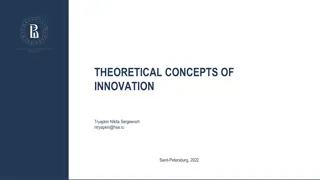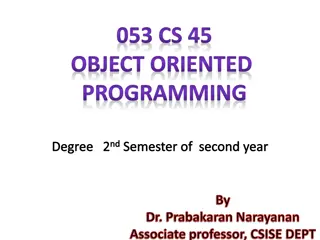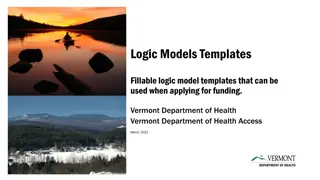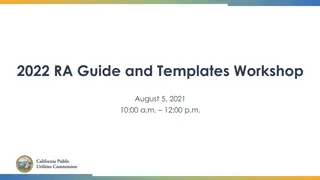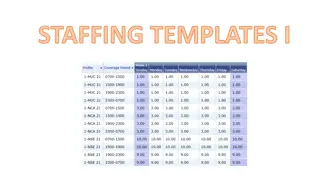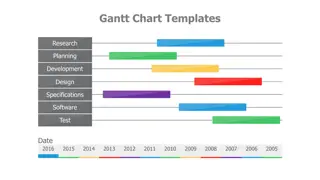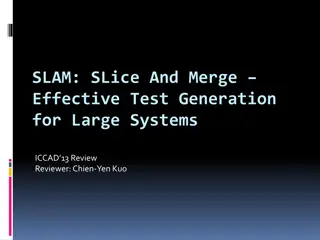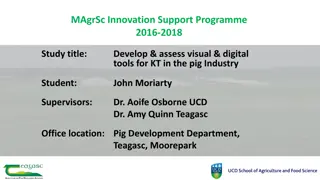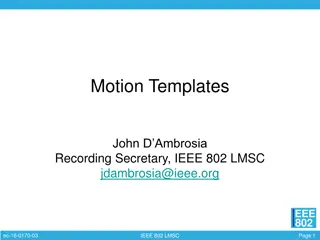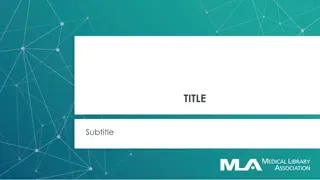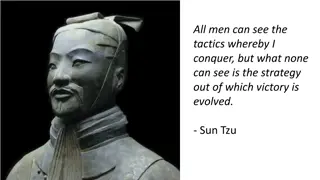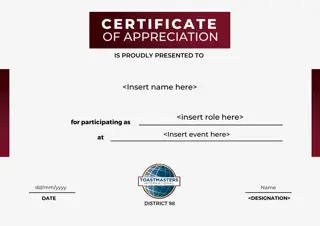Innovation Strategy Development: Templates and Tools
Explore a comprehensive guide for Innovation Strategy Development with hands-on templates and tools. Learn how to integrate partner logos, utilize color schemes, create agendas, and develop action plans successfully in a structured 10-step approach. Gain insights into client-focused strategic innovation management and stay ahead with trend analysis and competency assessments.
Download Presentation

Please find below an Image/Link to download the presentation.
The content on the website is provided AS IS for your information and personal use only. It may not be sold, licensed, or shared on other websites without obtaining consent from the author. Download presentation by click this link. If you encounter any issues during the download, it is possible that the publisher has removed the file from their server.
E N D
Presentation Transcript
Templates for Innovation Strategy Development
1 2 3 1 Integrate Partner Logo into Slide Master Go to View 2 Chose Slide-Master Please select the Main Page in the Menu Slide Master 3 Please DELETE gray placeholder after inserting your own logo 4 5 4 5 There you will find a placeholder for inserting your own logo 5 Using a template for the feedback and action plan presentation Click on the Slide Master tab and press Close the Master View Partner Logo 2
Title Arial 24 pt, regular, only 2 lines possible Subtitle Arial 18 pt, bold Flag Subhead 2nd level 16 pt, bold Subhead 2nd level 16 pt, bold Text on first level Second level - Third level xxx xxx xxx ### Table lines only inside Line 1 pt Line pt Title L1 L2 Order of think-cell colors 1 - L3 Regular Shape Tombstone, Arial 18 pt, bold, 2 lines possible Using a template for the feedback and action plan presentation Source: Any data presented in text or graph format should have a source identified Partner Logo 3
Color Scheme & Graphic Area 12,0 1,0 1,0 12,0 5,0 3,8 2,7 Colours RGB 77/77/77 RGB 95/95/95 RGB 150/150/150 RGB 178/178/178 RGB 221/221/221 Using a template for the feedback and action plan presentation 7,9 Partner Logo 4 Source: Any data presented in text or graph format should have a source identified 9,0
Divider Page 24-Point Bold Title Case Highlighted Subsections Place Divider Subsections as Bullets Using a template for the feedback and action plan presentation Partner Logo 5
Agenda Client s current strategic focus on innovation management Steps to develop an innovation strategy Action plan and next steps to develop and implement an innovation strategy successfully Example Partner Logo 6
The introduction to Innovation Strategy Development takes place in a hands-on 10 step approach. Training outline Search fields Vision and mission External analysis Internal analysis Innovation strategy Business case Competence roadmap Competency assessment Trends 10 Which trends affect the client? Which compe- tencies does the client have? Customer needs Innovation lifecycles What do the customers really need? Which current offerings are at the end of their lifecycle or still offering value to customers? Competitor and technology watch Ambition Who are the competitors and what are they doing? Ambition to serve new markets vs. ambition to develop new products Welcome and introduction Day 1 Day 2 Partner Logo 7 Source: IMP rove Academy, 2020; www.improve-innovation,eu; IMP rove is a registered trademark
Steps to develop an innovation strategy Using a template Partner Logo 8
Exercise: Define the most relevant trends for your client and identify the innovation potential and risks. Implication of Trend Interlinkage with other trends Innovation potential Trend Innovation risk Breakout session: Trend analysis Partner Logo 9 Source: IMP rove Academy 2020; www.improve-innovation.eu IMP rove is a registered trademark
You need to understand the innovation areas and control points in your client s value chain. 2. Value chain description End cust- omer Company Direct customers End Downstream value chain participants customers Company I I C I Value chain influencers I Innovation areas Important downstream customer value drivers that can be leveraged to client s benefit through innovation Control points Actors who control or strongly influence the value chain with regards to possible innovations (i.e. decision makers) Step 2: Customer needs analysis C I Innovation area Control point Partner Logo 10 Source: Kearney; IMP rove European Innovation Management Academy 2020
A competitor watch to profile and evaluate competitors serves to build a radar for shifts in a company s USP. Monitored criteria Competitors Product, service, business model feature Market presence Internet presence Special offers Competitor 1 specifics, changes, observations, indications, specifics, changes, observations, indications, specifics, changes, observations, indications, specifics, changes, observations, indications, Competitor 2 specifics, changes, observations, indications, specifics, changes, observations, indications, specifics, changes, observations, indications, specifics, changes, observations, indications, Competitor 3 specifics, changes, observations, indications, specifics, changes, observations, indications, specifics, changes, observations, indications, specifics, changes, observations, indications, 3. Profiling and evaluation Competitor n specifics, changes, observations, indications, specifics, changes, observations, indications, specifics, changes, observations, indications, specifics, changes, observations, indications, Any interesting observations shall be put on a watch list The watch list focuses the attention on the potential impacts An intern can update the watchlist at low cost Watch- list Step 3: Competitor and technology watch Partner Logo 11 Source: Global Business Policy Council, Kearney
To define your client s innovation strategy it is good to know which role they want to play now and in the future. 4. Innovation matrix (by Ansoff) Products, services, business models new to the world Changing the rules of the game Breakthrough innovation Trendsetter Lifecycle management Growth by innovation Products, services, business models new to the firm Market creation Business as usual Expansion Diversification Existing products, services, business models Existing market Market new to the firm Market new to the world Step 4: Ambition analysis Partner Logo 12 Source: Harry Igor Ansoff, IMP rove European Innovation Management Academy 2020
To give SME insights into their strengths and weaknesses regarding competencies a simple 5x5 matrix is very helpful. Very high - Industry leadership in competence area (significant lead compared to next competitor) High - Best practice in industry, yet no leadership in setting the pace Medium - Meets average industry competence level Low - Significant gap to reaching average competence Very low - Not reaching minimum industry norms Compete- nce level (of client and competitors) Very high Potential innovation leader Competence level High Risk of being squeezed out soon Me- dium Very high - Competence offers key differentiation in market (e.g. cost efficiency of process, major customer benefit) High - Competence offers direct and significant impact on competitiveness Medium - Competence is standard and expected in market Low - Competence is no "must" to be successful in market Very low - Competence has no influence on competiveness Low 6. Competence analysis Business at risk Very low Importance for compe- titiveness and innovation Very low Low Me- dium High Very high Importance for innovation Step 6: Competency assessment Partner Logo 13 Source: Kearney; IMP rove Academy 2020; www.improve-innovation.eu IMP rove is a registered trademark
Lifecycle maturity can be assessed by analyzing key indicators. 5. Criteria for assessment of as-is lifecycle maturity Phase introduction Phase growth Phase maturity Phase decline Dimension maturity Customers knowledge of as-is product performance None Low Medium High Number of products (grades) Unknown Increasing Stable Decreasing Patent activity Strongly increasing Emerging Stable Decreasing Entry barriers for new competitors Application know-how Cost / price advantage Basic R&D No attractiveness Platform share Growing fast Low Stable Decreasing Activities for developing new business models Growing fast Low Stable Decreasing Step 5: Innovation lifecycle analysis Partner Logo 14 Source: IMP rove European Innovation Management Academy 2020
Vision and mission are general principles that define what the company stands for and where it wants to go. Vision Mission Purpose Definition The dream The what and why Guide management's thinking on strategic issues Help define performance standards Guide employee decision making Help establish a framework for ethical behavior Internal Defines the optimal desired future state of what an organization wants to achieve over time Defines the company s business, its objectives and its approach to reach those objectives Description Developed first Developed only when the vision is available Timing Create closer linkages and better communication with customers, suppliers and alliance partners Promote external support External Success factors 7. Defining the vision and mission Understood and shared by all employees Broad enough to encompass a variety of perspectives Easy to communicate Inspiring and uplifting Concise and inclusive May be "action-oriented or outcome-oriented Findings1 On average - the bigger the SME size segment, the more companies do have a documented vision for all employees to see On average more than 50% clearly link their vision to innovation (across SME size segments) Step 7: Vision and mission 1. IMP rove assessment report Source: Kearney, IMP rove European Innovation Management Academy 2020 Partner Logo 15
Innovation Search Fields are derived from the (macro-) trends your client is facing. Product innovation trends & opportunities Product innovation search fields Relevance?1Addressed2 Description Faster curing silicone sealants Chemical XYZ as enabler for faster curing silicone sealants E.G. Depending on chemical XYZ ph, faster curing can be achieved Non-voc sealants Current product portfolio fully adequate Sealants using alcoxy Curing system Optimized chemical XYZ for alcoxy-based systems Substitution of alcoxy for oxime-based systems creates opportunity to optimize chemical XYZ products Sealants with improved adhesion properties Relevant for silanes, but not for chemical XYZ Example Special design features (e.G. Colored, matte, etc.) Current product portfolio fully adequate 8. From macro trends to search field High thermal stability Silicone sealants Chemical XYZ to enable greater thermal stability in silicone sealants Siti and tio2 can be added to increase thermal stability Anti-microbial sealants Silver doped chemical XYZ could replace existing organic biocides in Silicone sealants, but small market = Fully = Partially = Not at all = High = Medium = Low Step 8: Search fields 1. Impact on existing and potential for new products/applications 2. Degree addressed by current product/application portfolio: Source: Kearney Partner Logo 16
The identified search fields might require the development of new competences. Key questions to be answered Competence: Production process Competence: Engineering Does the SME has the resources to develop the competence Competence: Technical marketing Does the SME has the capability/ openness to integrate the new competence effectively Definition of level of quality of the competence Internal development vs. external hire or outsourcing Urgency for developing the required competence Resources required for the development of the competence (budget for training, salary of additional resources, recruiting etc.) Integration of new competence/ resources in the organization Continuous improvement measure for the competence Are there publicly available programs to support the competence development? Example 9. Approach to developing new competences Step 9: Competence roadmap Partner Logo 17 Source: IMP rove Academy 2020; www.improve-innovation,eu; IMP rove is a registered trademark
The business case is the pivotal element to convince SME clients to take action. Description of innovation activities Estimation of cost and benefits Overall results Assumptions and their individual contribution to scenarios Financial metrics Non-financial aspects Overall view on benefits of innovation activities Risk and sensitivity/ nprojections Practical advice for management on minimizing costs, increasing and accelerating benefits Scope/boundaries of proposed actions and functions included Clarity on business objectives Background situation and context 10. Business case success factors 2015 2016 2017 2018 2019 2020 Accumulated profit (scaling adjusted) Contribution margin of innovation R&D cost Step 10: Business case Partner Logo 18 Source: IMP rove European Innovation Management Academy 2020
Action plan and next steps to develop and implement an innovation strategy successfully Using a template Partner Logo 19
Developing an innovation strategy requires a rigorous management of the various actions Step Action Start End Responsible Action plan for developing an innovation strategy Partner Logo 20




